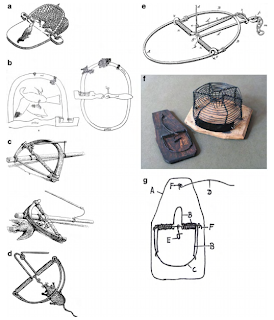PCR is a student-written and student-edited. This is the first edition. My AP Biology students will want to read through it since they will be expected to complete a research project and write a paper for publication in this journal. I'm hopeful that others will want to read some of the articles simply because they are interesting. Click on the image above to go to a .pdf version of the journal.
Monday, June 24, 2013
Pingry Community Research Journal
I'm pleased to share with you Pingry's newest publication--a journal dedicated to publishing experimental research conducted by our students.
Wednesday, June 19, 2013
Zombie Cockroaches, Killer Fungi and Evolving Mousetraps
I was thinking about the mousetrap analogy that refutes the idea of Irreducible Complexity. If you aren't familiar with it, here it is:
One thing that always bothered me about Miller's argument is that the mousetrap didn't, in fact, evolve. So, could it have evolved? There are many examples of traps in the natural world. I thought I'd collect a few for you.
Killer Fungi - Cordyceps are a group of fungi that infect insects and take over their minds.
Zombie Cockroach - More mind control. Here's a species of wasp that injects a neurochemical into the cockroach to allow the wasp to guide it into a grave. After laying eggs on the still-live cockroach, the wasp seals the tomb.
The Ant Lion - an animal that makes a trap for insects.
Fungi that make lassos
Venus flytrap - I think you'd have to call this an evolved trap.
And the grand finale - an actual mousetrap that evolved:
The mousetrap we are all familiar with was the product of people's imagination and there have been many variations, most of which never made money (went extinct). The simplest trap really is a small stick holding something heavy up. You put the bait on the stick. When the mouse eats the bait, the roof falls. Here's an interesting paper discussing it called Exploring Mouse Trap History.
Subscribe to:
Posts (Atom)


